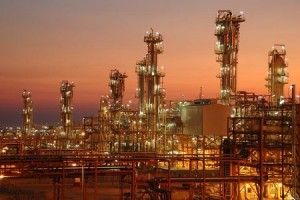 A view of Iran's South Pars Gas and Oil Field[/caption]
A view of Iran's South Pars Gas and Oil Field[/caption]Iran is set to start pumping natural gas from the biggest phase of the giant offshore South Pars gas field this week.
The first platform of phase 12 will become operational on Sunday, transferring 25 million cubic meters of natural gas to the Kangan Refinery by Friday, said Rasoul Fallahnejad, the project manager of the phase.
The refined natural gas will be injected into the national gas grid in February, he said.
Phase 12 is the South Pars� biggest phase in terms of volume of activities as well as investment and production levels, he said.
When fully operational, said the project manager, phase 12 will see some 75 million cubic meters (3 billion cubic feet) of sweet gas pumped into the national gas network per annum.
The project which is 93-percent complete has been implemented in a 220-hectare area, he said, adding it will also yield 120,000 barrels of gaseous condensates per day.
When fully operational, Fallahnejad said, the project will bring in USD 10-11 billion annually, which accounts for three percent of the country�s GDP.
Iran�s natural gas output currently stands at 500-550 million cubic meters per day, he said, and added phase 12 of the South Pars, when fully completed, will see domestic gas production rise by 15 percent (80 million cubic meters).
Iran, which sits on the world's second largest natural gas reserves after Russia, has been trying to enhance its gas production by increasing foreign and domestic investments, especially in South Pars gas field.
The South Pars gas field, divided into 28 phases, is located in the Persian Gulf on the common border between Iran and Qatar. The field is estimated to contain 14 trillion cubic meters of gas and 18 billion barrels of condensates.
The South Pars gas field covers an area of 9,700 square kilometers, 3,700 square kilometers of which lie in Iran's territorial waters in the Persian Gulf. The remaining 6,000 square kilometers, i.e. North Dome, are located in Qatar's territorial waters.
By Press TV
The Iran Project is not responsible for the content of quoted articles.










